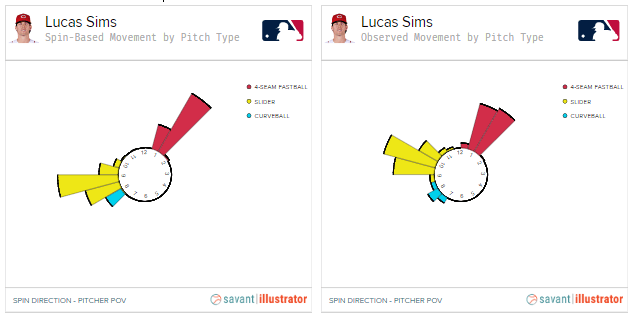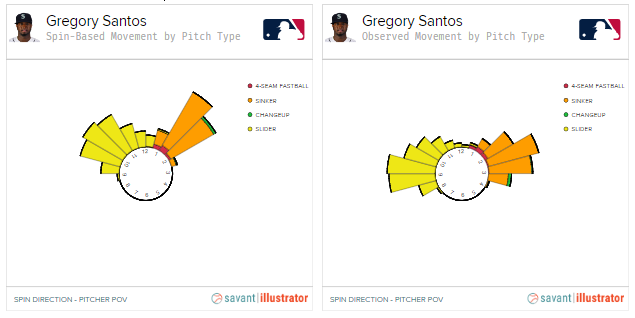What’s up everybody!
I’m in the midst of releasing my annual pitch review series where I take a look back at the five best pitches of each pitch type from 2023, as ranked by PLV! Today, I’m taking a look at the five best sliders from last year.
If you’d like a closer look at what this series is about, check out the first article in the series on the five best changeups of 2023 (also check out my list of the five best curveballs of 2023). And if you’d like an in-depth primer on what PLV is and how it works, check it out here.
Anyway, let’s dive into the five best sliders of 2023!
5. Lucas Sims
Man, it was fun to have Lucas Sims back in the league last year. After missing basically all of the 2022 season following back surgery, Sims returned last year and had a pretty solid season, posting a 3.10 ERA over 61 innings in a setup role for the Reds.
A large part of that success came from Sims’ slider, which is a sight to behold. The pitch spins like you would not believe. In fact, per Statcast, Sims’ slider had the most spin of any slider in all of baseball at 3,002 RPM. And what’s more, the way his slider spins is pretty deceptive. Take a look at his spin-based movement versus his observed movement:

The long and short of the above graphic is, Sims’ slider should be moving in a different way based on its spin, but thanks to some other aerodynamic forces (like some seam-shifted wake), it spins in a different way, which makes it pretty deceptive. On top of that, the pitch gets 3.3 inches of induced vertical break and 16.6 inches of induced horizontal break, both of which are well above average.
Basically, Lucas Sims has a filthy slider, and it worked pretty darn well last year, with a 34% chase rate, 20% swinging-strike rate, and a 36.7% CSW alongside a 30% ICR and .260 wOBA against. It very much deserves to be on this list.
4. Andrew Nardi
For his first full season in the majors, Andrew Nardi did not disappoint as a setup guy for the Marlins, posting a 2.67 ERA, a 30.8% strikeout rate, and 17 holds through 57.1 innings.
Nardi went with a fastball/slider approach last year, keeping his fastballs up (63% hiLoc rate last year) and locating his slider down and away to righties, and it worked great. He gets great extension on his fastball at 6.8 feet and has pretty solid iVB at 15.6 inches.
And it pairs well with the slider, which posted a 34.7% chase rate, 16.3% swinging-strike rate, and a 32% CSW, all above-average numbers, alongside a solid 34.7% ICR and a .271 wOBA against. The pitch has a ton of movement—15.1 inches of induced horizontal break to be exact, which is a lot, and it worked great last year.
3. Kyle Bradish
If there’s one thing that makes Kyle Bradish awesome, it’s his slider. Last year, he threw it more than any other pitch (31% of the time) and for a good reason—it’s filthy.
Last year, the pitch had a 32.9% chase rate, 17.8% swinging-strike rate, and a 30.7% CSW to go along with a 35.9% ICR and a .210 wOBA against. Basically, the pitch was good at missing bats and excellent at inducing weak contact.
The problems with Bradish come elsewhere in his repertoire. Now, I say problems but I acknowledge it’s hard to say that a guy who posted a 2.83 ERA with a 25% strikeout rate over 30 starts really had any problems, but he did.
The main issue with Bradish is his fastball, which was not great last year. It’s listed as a four-seamer but if you watch the pitch, it looks a lot more like a cutter, but Bradish doesn’t treat it like a cutter (it’d be cool if he did), and hitters teed off on it, with a 46.3% ICR and a .452 wOBA against. That’s not what you want from your second most-thrown pitch. Luckily, he started using the sinker a bit more and it turned out better, with a 31.2% ICR and .306 wOBA against.
Bradish also sported a curveball last year but only threw it 17% of the time. It’s not a major strikeout pitch or anything (that’s what his slider is for) but it still missed some bats with a 33% CSW and 18.4% swinging-strike rate and it induced weak contact at a pretty good clip, with a 33.3% ICR and .150 wOBA against.
That slider is a work of art, and I would love to see Bradish tweak things around, maybe utilize the sinker more, definitely utilize the curveball more—especially to lefties—and treat his fastball like a cutter, locating it differently. The potential is there for him to be consistently good. Obviously, he was awesome last year, but his 2.86 ERA also came with a 3.60 xERA, 3.27 FIP, and 3.46 xFIP, so there was likely a dash of luck involved. But if he tweaks his approach, which he’s done before, and centers it all around that killer slider, Bradish could consistently be an awesome pitcher.
All of that said, Bradish is unfortunately sidelined with a UCL sprain, which is pretty scary and could easily mean he ends up needing Tommy John surgery, which would be a serious bummer, cause man is he fun to watch (and I’m not just saying that because I’m an Orioles fan [jk maybe I am]).
Gregory Santos got his first full year in the majors last year for the White Sox and was pretty solid, posting a 3.39 ERA through 66.1 innings and grabbing a couple holds and saves here and there.
Santos’s approach is pretty simple—it’s a sinker/slider mix, but he primarily throws the slider, and the numbers on the pitch are something else. Last year, Santos’ slider had a 41.3% chase rate, 19.8% swinging-strike rate, and a 36.9% CSW alongside a 35% ICR and .203 wOBA against.
It’s a great slider that comes in pretty fast at 91.4 MPH on average and has some decent movement, though nothing over the top. The main appeal of this slider is that it comes in at a fairly high VAA and much faster than most sliders with a pretty good spin.
And similar to Lucas Sims, the spin on Santos’ slider is pretty deceptive:

All in all it’s a really solid slider, and paired with his sinker which comes in really fast (98.8 MPH on average) with really high spin (2,374 RPM—good for 94th percentile in the majors among relievers), it helped Santos be a pretty effective reliever last year.
1. Matt Manning
Without a doubt, there is plenty of potential in Matt Manning. I mean, he’s topping this list of the best sliders in baseball last year because his slider put in the third-best PLV of any pitch in all of baseball last year, there’s something to be said for that.
And we’ll get to that slider in a moment, but it’s also worth noting there’s plenty about Manning that’s worrisome for this season too. If you look at his season last year, you might be encouraged—this is a former top prospect guy who started 15 games and pitched to a 3.58 ERA and a solid 6.6% walk rate, that’s pretty awesome.
But then when you dive further into his numbers, that’s where things get dicey. Manning had a .216 BABIP last year, good for 98th percentile in the majors, as well as a 10.9% HR/FB rate, good for 85th percentile. Now, far be it from me to cite BABIP as the end all be all indicator of a guy getting lucky, but a BABIP that extremely low is not going to stick, and it’s likely what Manning’s 3.58 ERA also came with a 5.01 xERA and a 4.80 FIP.
The real concern with Manning is his repertoire. This slider is not one of those concerns—last year he threw the pitch 32% of the time (his second most-thrown pitch) and the numbers it returned are great. It’s not a whiff pitch, that’s important to note. Sure, its 28.7% chase rate and 12.9% swinging-strike rate are fine, but what makes this slider so good is how well Manning commands it.
Last year, Manning’s slider had a 53.4% zone rate, which is exceptionally high for a slider, and as a result, it turned in an 18.2% called strike rate (which is also quite high), helping guide it to a pretty solid 31.1% CSW.
It’s a pitch that Manning frequently used early in counts, and when hitters made contact with it, they didn’t do a whole lot with it. The pitch had a 31.9% ICR and a .275 wOBA against—it’s just a pitch that hitters couldn’t really do anything with.
Manning’s most-thrown pitch was his fastball, and there are definitely some things to really like about Manning’s fastball. He gets elite extension on the pitch—7.1 feet, which is good for 93rd percentile in the majors—and he gets a super high VAA and pretty solid induced vertical break.
All of that should make for an elite, Zack Wheeler-type fastball, but the problem is, Manning’s fastball only comes in around 93 MPH on average and he locates it low in the zone way more than he should. Last year, Manning’s fastball had a loLoc of 34.5% (96th percentile in the league) and a hiLoc of just 38.2% (5th percentile in the league).
If you’re a pitcher getting elite extension and VAA plus solid iVB on your fastball, you really should be locating the pitch high in the zone more than Manning is, even if the velocity isn’t super great.
On top of that, Manning has a curveball and changeup, neither of which is particularly special, effectively making him a two-pitch pitcher. Yeah, that slider is awesome, but paired with a (so far) pretty middle-of-the-road fastball and two unimpressive other pitches in his curveball and changeup, plus a good bit of luck from last year, makes Manning a worry from a fantasy perspective going into the season.
Now, if the fastball jumps up a few ticks in velocity and he starts locating it up in the zone more, then color me curious.

